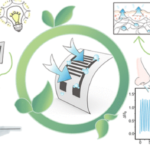2023-02-02 カリフォルニア大学サンタバーバラ校(UCSB)
◆機械工学のパオロ・ルッツァット・フェギス教授(リンクは外部サイト)は語る。「理論はできていたのですが、非常に厄介な問題でした。超疎水性表面は、貨物船のように水中を移動するものの効率を低下させ、パイプを通して液体を送り出す際のエネルギー消費を増加させる現象である抗力を解決する可能性があると考えられているのである。この研究室では、10個の複雑なパラメータを用いて効果的な水素貯蔵システムを計算したが、その結果、水素貯蔵システムの性能を予測する能力は、たった1個に集約されることが判明した。」
◆この研究成果は、米国科学アカデミー紀要に掲載されています。
◆Luzzatto-Fegiz氏は、超疎水性表面は、小さな空気のポケットを作ることによって、表面と液体の接触を最小限に抑えるように設計されていると説明する。例えば、新鮮なケールを水につけたときのような感じです。微細な表面構造のおかげで、葉は銀色の光沢を帯びている。これは、気泡のネットワークが葉の表面に水が触れるのを防ぐためで、ロータス効果とも呼ばれる。
◆植物にとって、超疎水性はセルフクリーニング効果をもたらし、真菌感染症などの水系疾患を防ぐのに役立つ。また、無機物の表面では、空気抵抗を減らす効果がある。しかし、コンセプトは正しいのですが、実際には、水と泡の中の空気との間の張力を弱める化合物である界面活性剤のために、表面のパターン化は望ましい効果を発揮していませんでした。ルッツァット・フェギズ教授によると、現実の環境では界面活性剤の混入は避けられず、たとえ微量でもSHSの性能を損なう可能性があるとのことだ。
◆研究者たちは、界面活性剤の影響を克服する表面を設計するために、すでに複雑になっている流体力学だけでなく、界面活性剤分子の物理学を含む複雑な計算と格闘しなければならなかった。
◆「水中でどのように動くのか、水中から界面へどのようにホップするのか、どのように輸送されるのか、などのモデルが必要でした」と彼は言う。しかし、実験、モデリング、計算の過程で、他のすべてのパラメータを凌駕するような、ある1つのパラメータが浮かび上がりました。
◆「気泡の長さです」とルッツァット・フェギズ教授は言う。「多くのパラメータは、現実にはそれほど大きくは変化しないのです」。この制約のもとで、彼らは、いくつかの要因が相殺され、小さな溝の長さスケールだけが残ることに気づきました。つまり、エアポケットを形成する微細な溝が長ければ長いほど、界面活性剤分子の効果は小さくなる。
◆その結果、界面活性剤の種類や濃度によって、臨界エアポケット長というものがあることがわかりました。「グレーティングを長くすると、通常は10センチ程度ですが、界面活性剤が流体の動きに抵抗することができなくなります。「と彼は言いました。「そして、人々が20年間探し求めてきた、理想的な抗力低減を手に入れることができるのです。
◆これらの計算がうまく解決されたので、研究者たちは、小さな柱などの他のタイプのSHSパターンや、乱流などの非定常流などの現実の状況について調べ始める予定です。さまざまな状況で抵抗を減らすことができれば、燃費のよい貨物船、効率のよいポンプ、流水中の弾力性のある構造物などを実現できるだろう。
<関連情報>
- https://www.news.ucsb.edu/2023/020830/streamlining-situation
- https://www.pnas.org/doi/10.1073/pnas.2211092120
界面活性剤による超疎水性抗力低減の阻害を単一のパラメータで予測することができる A single parameter can predict surfactant impairment of superhydrophobic drag reduction
Fernando Temprano-Coleto ,Scott M. Smith,François J. Peaudecerf ,Julien R. Landel ,Frédéric Gibou ,Paolo Luzzatto-Fegiz
Proceedings of the National Academy of Sciences Published:January 12, 2023
DOI:https://doi.org/10.1073/pnas.2211092120

Significance
Trace surfactants, unavoidable in applications, can impair the drag reduction achieved by superhydrophobic surfaces (SHS) as Marangoni stresses immobilize the air–water interface. It is not known how SHS impairment depends on surfactant type and concentration, flow velocity, and SHS geometry; as a result, mitigation strategies are still needed. We introduce a model of this phenomenon and perform simulations and experiments. We find that the interface can be mobilized if it is longer than a critical length scale, which is determined by the surfactant properties, essentially independently of flow velocity. SHS impairment is thereby predicted from a single parameter, namely the ratio of interface length and mobilization scale, providing fundamental insight and practical guidance to achieve superhydrophobic drag reduction.
Abstract
Recent experimental and computational investigations have shown that trace amounts of surfactants, unavoidable in practice, can critically impair the drag reduction of superhydrophobic surfaces (SHSs), by inducing Marangoni stresses at the air–liquid interface. However, predictive models for realistic SHS geometries do not yet exist, which has limited the understanding and mitigation of these adverse surfactant effects. To address this issue, we derive a model for laminar, three-dimensional flow over SHS gratings as a function of geometry and soluble surfactant properties, which together encompass 10 dimensionless groups. We establish that the grating length g is the key geometric parameter and predict that the ratio between actual and surfactant-free slip increases with g2. Guided by our model, we perform synergistic numerical simulations and microfluidic experiments, finding good agreement with the theory as we vary surfactant type and SHS geometry. Our model also enables the estimation, based on velocity measurements, of a priori unknown properties of surfactants inherently present in microfluidic systems. For SHSs, we show that surfactant effects can be predicted by a single parameter, representing the ratio between the grating length and the interface length scale beyond which the flow mobilizes the air–water interface. This mobilization length is more sensitive to the surfactant chemistry than to its concentration, such that even trace-level contaminants may significantly increase drag if they are highly surface active. These findings advance the fundamental understanding of realistic interfacial flows and provide practical strategies to maximize superhydrophobic drag reduction.



